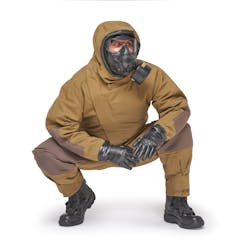Industry Insights: Considerations When Selecting Tactical Response Gear
Editor's note: Industry Insights are sponsored blogs submitted by manufacturers and suppliers serving the fire service industry.
Responding to events that potentially involve hazardous materials or chemical, biological, radiological, or nuclear (CBRN) agents require specialized garments. With recent updates to the NFPA 1994 Standard on Protective Ensembles for First Responders to Hazardous Materials Emergencies and CBRN Terrorism Incidents, selecting the right gear for these types of missions now includes several new options you should consider.
Certified protection
The NFPA 1994 Standard differentiates the type of protection based on whether the level of contaminant concentration is above or below a level that is immediately dangerous to life and health (IDLH). Garments certified to classes 1 and 2 deliver protection above IDLH and require the use of a self-contained breathing apparatus (SCBA), whereas those certified to classes 3 and 4 provide protection below IDLH and allow the use of an APR/PAPR.
If you respond to calls that require tactical entry or search and rescue, you may be interested in the addition of the ruggedized categories (Type R) for NFPA 1994 Class 2, 3, and 4 certifications. To be certified as a ruggedized garment, material samples are rigorously preconditioned and then must pass barrier testing and higher levels of physical property performance. With this more rigorous testing, a Type R garment is designed for more challenging environments.
Durability and design
Once you are confident that the garment will provide protection against the hazardous chemicals or CBRN agents you might encounter, you should also evaluate its durability and design.
Certified to NFPA 1994, Class 3R, 4R, and NFPA 1992 Standards, the Ruggedized Class 3 suit made of GORE® CHEMPAK® selectively permeable fabric, enables you to respond confidently during tactical entry and search & rescue missions.
Are the stress points reinforced or padded? For tactical entry or search & rescue missions that may include collapsed structures or confined spaces, you need a suit that can withstand the harsh surroundings found in these types of environments. You should consider what type of abrasion and mechanical strength testing has been performed on the garment. For example, W. L. Gore & Associates’ development team wanted to ensure that its Ruggedized Class 3 Suit made with GORE® CHEMPAK® selectively permeable fabric could withstand the rigorous use associated with these types of operations better and provide a greater level of cut and puncture resistance than the current Class 3 ensembles. They confirmed the fabric’s durability by using both the Mullen burst test and the aggressive Taber abrasion test.
Also, wearing a more form-fitting garment can increase your operational effectiveness and reduce the possibility of cuts and tears that can compromise your protection. Therefore, it is important to consider the design of the garment. How form-fitting is it? Will you be able to crawl through tight spaces easily? Will your visibility be compromised?
Being able to focus on the mission and respond confidently that the suit will remain intact is crucial for CBRN responders.
Staying actively involved
Responding to large-scale events can require extended hours in environments with high temperatures and humidity. Also, materials used in protective clothing can interfere with the flow of sweat vapor into the environment. Both of these can increase heat stress, resulting in shorter times of on-scene engagement. Therefore, having a suit that is more breathable can help reduce heat stress and increase your time on scene.
The 2018 edition of the NFPA 1994 Standard requires that Class 3/3R and Class 4/4R ensembles meet specific breathability requirements. The evaporative resistance test (Ret), measures material breathability by determining the amount of resistance that sweat vapor encounters when passing through a fabric: the lower the resistance value, the more breathable the fabric is.
It is important that you consider the testing done to determine whether the fabric used in a suit’s construction is breathable. Gore’s development team knew that tactical response and search & rescue events can be extensive, so they wanted to ensure that the fabric was as breathable as possible while maintaining the durable protection needed. When tested for NFPA 1994 component certification, the GORE® CHEMPAK® selectively permeable fabric measured almost 2.5 times better than what was required for the Ret test. This translates to lower heat stress provided by a highly breathable suit, which allows for longer mission times when compared to an impermeable suit.
In conclusion, specialized garments are critical for protecting you when responding to events that potentially involve hazardous materials or chemical, biological, radiological, or nuclear (CBRN) agents. The NFPA 1994 Standard, 2018 edition includes several changes that can affect your gear selection. The definitions of garment classes have been expanded to allow new considerations for certified protection, durability, garment design, and breathability — enabling you to choose the right gear to accomplish your mission. For more information, visit GoreChempak.com.
About the Author

Jason A. Horowitz
Jason is currently a product manager for GORE® CHEMPAK® fabrics, chemical biological protective fabrics for first responders to CBRN and hazmat incidents. Jason is committed to delivering personal protective equipment with enhanced functionality to first responders in military, law enforcement, and fire and safety markets. Jason is an active member of the National Fire Protection Association and serves on the Hazardous Materials Protective Clothing & Equipment (NFPA 1991, 1992, & 1994 Standards) Technical Committee. Jason has a Bachelor of Science in chemical engineering from Lehigh University and a Masters of business administration from Villanova University. For information about Gore’s products, visit GoreProtectiveFabrics.com.
